Contents


Differences between clementine and mandarin are associated with the color and structure of the peel, as well as the shape of the fruit. Outwardly, they are very similar to each other. Tangerines have an oval flattened shape, and clementines have a classic rounded shape. The taste of the latter is sweeter, while sourness is noticeable in the pulp of the former. At the same time, both citrus fruits are very useful for the body, they are used even in dietary nutrition.
What are clementines and tangerines
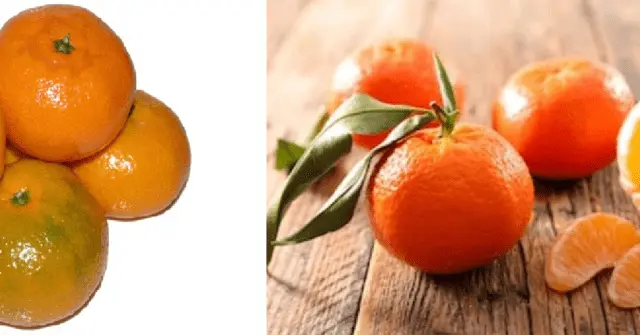
Mandarin and clementine are citrus fruits from the Rutaceae family.
These are related cultures, but mandarin appeared much earlier. It is an independent species. Clementine was bred over a century ago. This is a hybrid based on mandarin and king orange.
The main difference between the fruits is associated with the following parameters:
- the form;
- crust structure;
- Colour;
- taste;
- aroma.
What is the difference between clementines and mandarins
Distinguishing clementine from mandarin is not so easy, because they are similar in shape, size and color of the fruit. If you look more closely, you can see the differences. A certain difference is associated with taste.
History of origin
If you briefly study the history of origin, you will notice that the mandarin is much older than the clementine. The culture is ancient, it has been grown for several millennia. Initially, tangerine gardens were located in India, and a few centuries later they appeared in China.
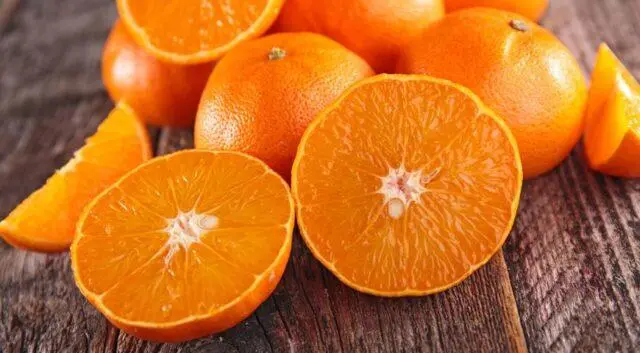
70% of citrus fruits exported from Morocco are actually clementines (although they are sold under the trade name “tangerines”)
For a long time, the plant was considered exotic – the fruits were served only to the emperor and high officials. In the late Middle Ages, tangerines became publicly available. Already in the 16th century, fruits came to Europe. They appeared on the territory of modern Spain, Italy, Greece, Turkey, Georgia.
Then from China, tangerines came to Japan. From Turkey, the culture was brought to Morocco, where they began to grow on an industrial scale. In Our Country, they first appeared only in the 70s of the XIX century. Moreover, initially tangerines were not a symbol of the new year. Two decades later, the first tangerine plantations appeared in Georgia and Abkhazia. But mass distribution began only in the mid-60s of the XX century.
Clementine is a hybrid of mandarin and king orange. This is a related culture, which was subsequently separated into a separate species with many varieties. Moreover, clementine received an independent status only in 1902. The name is associated with the name of the French missionary Clement Rodier. It was he who discovered the hybrid grown in one of the shelters in Algeria.
Although there is another version of the origin of clementine, according to which it appeared much earlier than 1902. The fruit originated in Asian countries, then it began to be grown in the Mediterranean region. Over time, it spread to Europe and Our Country.
Description of fruits
First of all, tangerines differ from clementines in appearance.
Tangerine fruits have a thin peel of yellow color. Between the skin and the pulp itself, the space is loose, filled with a substance of a spongy consistency. Due to this, the crust is very easily separated from the main mass. In the layer, glands of spherical shape are noticeable. They contain essential oil, so they give maximum aroma. The shape of the fruit is rounded, noticeably flattened above and below. The pulp is yellow-orange, hidden in slices from 10 to 12. Each of them contains seeds (1-2 pieces).
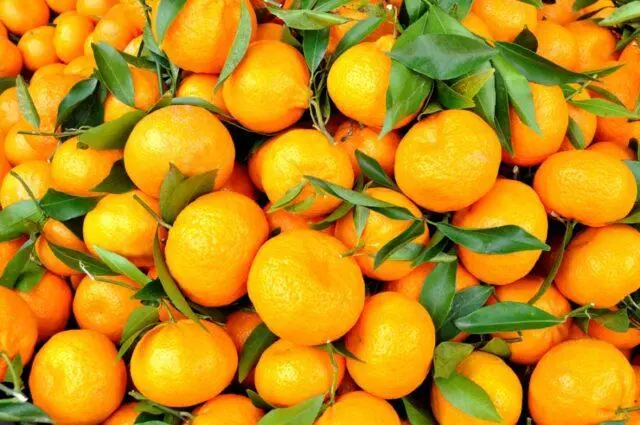
Clementine fruits have several dense leaves on the stalk
It is the leaf plates that deteriorate first, so you can find out how fresh the product is. Skin rich yellow-orange, slightly reddish. At the same time, the shape is not flattened, it is round and resembles an orange, although clementines are smaller in size. Since there is no loose layer under the skin, it is noticeably more difficult to separate from the pulp.
Palatability
You can also distinguish fruits by taste.
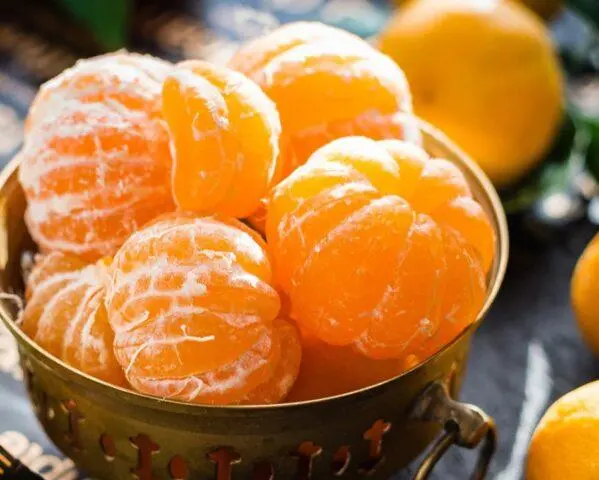
Mandarin pulp contains both sweet and sour undertones
Mandarin taste is balanced, refreshing. The aroma is bright, characteristic of citrus fruits.
As for clementine, it has a sweeter taste, often pronounced, without sourness. The aroma, on the contrary, is not so noticeable.
What do clementines and tangerines have in common?
Despite the differences, both citrus fruits have several similarities. The fruits are approximately the same size, rounded and orange-yellow in color. The taste and aroma are also approximately similar, although they do not completely match. The main similarities are related to the chemical composition:
- glucose
- fructose;
- organic acids;
- pectins;
- essential oils;
- vitamins E, C, PP;
- mineral salts;
- trace elements (including cobalt, molybdenum, fluorine, potassium, silicon, calcium and manganese);
- volatile production.
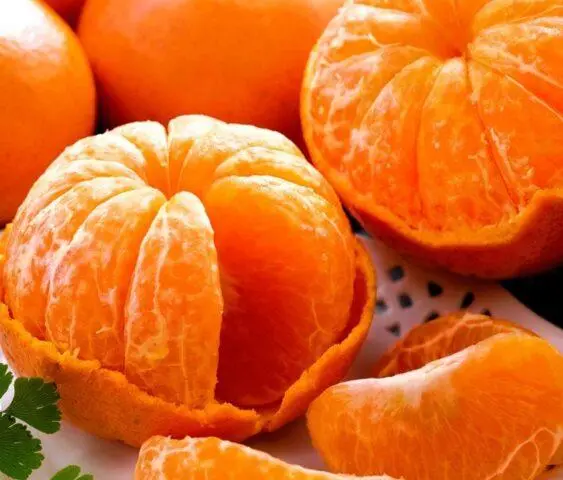
Tangerines and clementines contain many vitamins, minerals and other valuable components.
Due to the diverse chemical composition, citruses bring great benefits to the body. First of all, they strengthen the immune system. So, 100 g of mandarin pulp contains more than 40% of the daily requirement of vitamin C, and clementine has more than 50% for the same mass.
Both fruits are low-calorie: tangerine fruits – 33 kcal per 100 g, and clementine – 47 kcal. The glycemic index is not more than 50, which allows the use of citrus fruits in moderation, even with diabetes. The fruits also contain dietary fiber (up to 10% of the daily requirement in 100 g). These are useful substances that stimulate intestinal motility and significantly improve digestion.
The similarity of both citrus fruits is also associated with useful properties:
- strengthening the heart muscle;
- improvement of immunity;
- increased endurance;
- prevention of respiratory diseases;
- restoration of vision;
- increased mood;
- stress relief;
- elimination of sleep problems;
- normalization of weight (fruits can be used for fasting days).
There are certain differences in the composition of citrus fruits. Mandarin contains a rather rare organic substance called nobiletin. It promotes the removal of cholesterol from the liver, thereby reducing the risk of such dangerous pathologies as heart attack and stroke. In addition, nobiletin stimulates the body, which has a beneficial effect on metabolism.
Tangerine juice is used as an antifungal agent – for this, external compresses are made. The composition contains folic acid, which helps to cope with menstrual irregularities. It also contributes to the proper formation of the fetus, therefore, in small quantities, tangerines should be consumed during pregnancy.
Clementine is different in that it contains a large amount of vitamin C. Just two fruits are enough to fill the daily requirement of this vital substance. In addition, the pulp helps in the treatment of pathologies such as gastroduodenitis and cholecystitis. Active substances eliminate pain in ulcers and inflammation in the intestines.
Conclusion
Differences between clementine and mandarin are not always noticeable visually. But if you look closely, you can see that tangerines have a flattened shape and not such a rich color. If you crush the fruit in your hands, you can feel that it is much more loose. And the taste of citrus is more sour, while clementine, on the contrary, is sweet.









